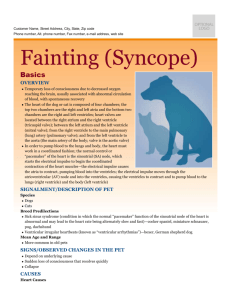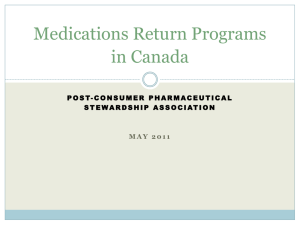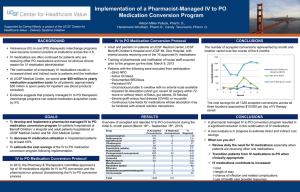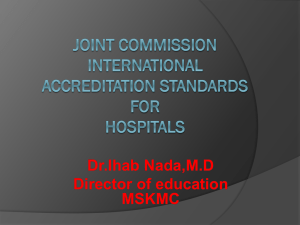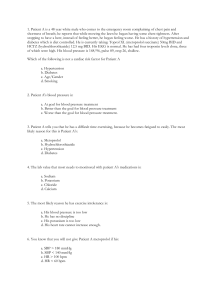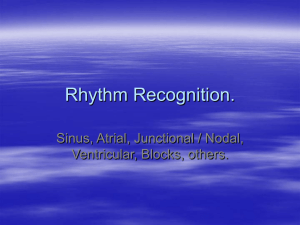Heart rhythm 101
advertisement
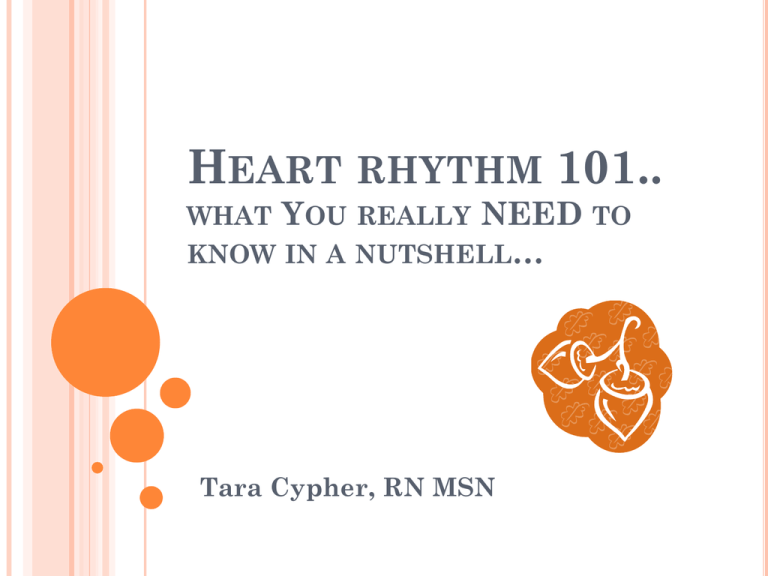
HEART RHYTHM 101.. WHAT YOU REALLY NEED TO KNOW IN A NUTSHELL… Tara Cypher, RN MSN WHY IS THIS SOMETHING TO WORRY ABOUT??? According to the NHI, approx 1 in 18 or 14.4 million people in USA have a diagnosis of an irregular heart rhythm In order to understand when something is wrong, we need to know how the heart works We have hands on time and the opportunity to recognize changes in our patients condition. We need to recognize what is “normal” and what is a potential problem THE ANATOMY OF THE HEART PHYSIOLOGY OF THE HEART…HOW DOES THE MAGIC HAPPEN??? TWO important concepts: 1. Electrical activity in the heart 2. Mechanical contraction of the heart BLOOD FLOW THROUGH THE HEART http://youtu.be/7XaftdE_h60 BLOOD FLOW THROUGH THE HEART Deoxygenated blood from the Superior and Inferior Vena cava enter the RIGHT ATRIUM Blood Flows from the Right Atrium through the TRICUSPID valve into the Right Ventricle Blood is pumped from the RIGHT VENTRICLE through the PULMONARY VALVE to the Pulmonary Arteries The Pulmonary Arteries bring blood to the lungs to be oxygenated BLOOD FLOW THROUGH THE HEART Oxygenated blood comes back to the heart from the PULMONARY VEINS The Pulmonary Veins enter the LEFT ATRIUM The oxygenated blood passes through the MITRAL (BICUSPID) Valve to the Left Ventricle The LEFT VENTRICLE pumps blood through the AORTIC valve into the AORTA The Aorta is our largest artery, branching off to deliver oxygenated blood to our body Capillaries serve as small exchange vessels between arteries and veins where nutrients and gasses diffuse The heart consists of two parallel pumps. • The right ventricle pumps blood through the lungs. • The left ventricle pumps blood through the systemic circulation– the body THE HEART AS A PUMP http://youtu.be/84PrHxJri9Q THE HEART AS A PUMP The RIGHT and LEFT side are pumping at the SAME time… The right pumps to the lungs The left pumps to the body When we listen to the heart, TWO sounds should be heard 1. S1: LUB: Tricuspid and Mitral Valve closing o 2. S2: DUB: Pulmonary and Aortic Valve closing Any extra heart sounds are called a MURMER HOW DOES THE HEART PUMP??? The heart needs “electricity’ to start the pump The heart is made of specialized muscle tissue to conduct electricity The heart as special nodes, branches and fibers so the signals can pass quickly through the heart THIS IS WHERE THE ION CHANNELS COME IN…. Like all muscle cells in the body, the heart depends K, Na, and Ca channels for contraction… The pacemakers of the heart (the SA node, AV node, Bundle of HIS and Purkinge Fibers) have specialized cells to make heart muscle contraction more efficient All have specific “refractory” periods when they will not get “excited” or depolarize and cause contraction of heart muscle IONS AND THE HEART ELECTRICAL ACTIVITY IN THE HEART http://youtu.be/v3b-YhZmQu8 NORMAL SINUS RHYTHM THE HEART WORKS BEST WHEN THE SINUS NODE RUNS THE SHOW All cells in the heart are capable of electrical activity…but the heart works much better when the SINUS NODE (the fastest internal pacemaker) takes the lead and the heart contracts in an organized fashion Normal Sinus Rhythm is meant to depolarize the atria uniformly, gives the AV valves time to close, then depolarize the ventricles evenly to the lungs and the body…but this is not a perfect world Arrythmias are common EXAMPLES OF PROBLEMS WHEN THE ELECTRICAL ACTIVITY IS OUT OF WHACK… Premature beats…we all have them! Atrial Fibrillation….the most common Atrial Tachycardia Junctional Rhythm SVT Heart blocks Ventricular Tachycardia Ventricular Fibrillation PREMATURE BEATS Premature Atrial Contractions PREMATURE BEAT Premature Ventricular Contraction ATRIAL FIBRILLATION Nothing regular about it… ATRIAL TACHYCARDIA The atria are contracting 1, 2, 3, 4, etc times for each ventricular contraction SUPRAVENTRICULAR TACHYCARDIA Its just too fast… JUNCTIONAL RHYTHM FIRST DEGREE HEART BLOCK SECOND DEGREE HEART BLOCK: II Mobitz Type 2 SECOND DEGREE HEART BLOCK: I Mobitz Type 1: Wenckebach THIRD DEGREE HEART BLOCK Complete Heart Block.....BAD NEWS VENTRICULAR TACHYCARDIA Get ready to shock ladies and gentleman… VENTRICULAR FIBRILLATION The heart is just quivering…ouch ASYSTOLE Nothing good…but always check your leads! WHAT ARE THE BIG THINGS I NEED TO LOOK OUT FOR??? 1. Heart rate and pulse 2. Common medications that slow down or speed up the heart 3. Common problems with abnormal heart rhythms…like clots! 4. Many medications or conditions that increase or decrease K, Na or Ca COULD AFFECT THE HEART MEDICATIONS THAT SPEED UP THE HEART Keep in mind, pacemakers are usually placed for slow heart rhythms In an emergency, IV medications are given to speed up heart rate Many medications may speed up heart rate as a side effect…when in doubt, look it up! Cold medications, Caffiene, Allergy Medications, Diet medications, some cough medications, thyroid medications, some blood pressure medications MEDICATIONS THAT BLOCK IMPULSES Na Channels: Procainamide, Quinidine, Lidocaine, Flecainide Beta nerve impulses: Atenolol, Metoprolol, Carvedilol, Nadolol, Esmolol, etc Potassium: Amiodarone (Cordarone®), Dofetilide (Tikosyn®), Ibutilide (Corvert®), Sotalol (Betapace®), Tedisamil Calcium: Diltiazim (Cardizem®), Verapamil HEART RATE VS PULSE The heart rate is the electrical impulses, the pulse is the mechanical output Need to listen/feel how that beat is pumping blood Not all beats are created equally TAKE HOME MESSAGE: Electrical activity does not always mean good mechanical contraction of the heart WHAT DOES THIS MEAN TO ME? Check the HR and pulse BEFORE giving any drug for the heart Check with the patient…how is the mental status, how are their other vital signs?? Double check the orders…when to hold the medication, etc. Anything fast or slow NEEDS TO BE ADDRESSED. Document and tell someone. When in doubt, ASK. ALWAYS. Medications are hard to take back. POP QUIZ! You enter Mrs. X’s room at your rehab facility to pass evening medications. She is 81 yrs old, recovering from hip surgery. She has had a fever and a “cold” for the last 2 days. She is ordered to receive Sudafed to relieve nasal congestion. Mrs. X states she is feeling very weak. She sounds short of breath with minimal exertion. As a diligent LPN, you check her pulse and her blood pressure Her BP is 88/60, her pulse is 160 and feels thready. Her temperature is 99.9, her oxygen saturation is 91% but it is difficult to get a good reading. WHAT DO YOU DO FOR MRS. X??? A. Give her the cold medicine and a glass of water. She could be dehydrated. B. Ask her if she would like Tylenol for her fever, as she has a standing order for this medication C. Notify the charge nurse/MD that Mrs. X needs immediate attention. D. Write down the vital signs and come back to Mrs. X when you are finished with your other patients? C. NOTIFY THE CHARGE NURSE/MD ON CALL Mrs. X needs immediate intervention, as she potentially unstable in a fast arrythmia!! Upon returning from lunch, you receive report that one of your patients has been “confused” and “agitated” The Nursing Assistant reports that Mr. Q’s blood pressure is 180/109 and his heart rate is 55 on the cardiac monitor You enter the room of Mr. Q, and find him trying to get out of bed. He does not recognize you. He is sweating and appears pale. He is grimacing and rubbing his left shoulder and chest You can feel a pulse but it is weak. WHAT DO YOU DO FOR MR. Q A. Try to get an order for restraints. He is at high risk for falls B. Bring in his daughter to see if he recognizes her. He has a history of dementia. C. Give him is scheduled blood pressure medication D. Call the physician and ask for help D. CALL THE PHYSICIAN AND GET HELP Mr. Q is unstable, with a symptomatic bradycardia– Possible heart attack! BONUS ROUND!! NAME THAT RHYTHM!!! THE GOOD THE BAD AND THE UGLY!!! THANK YOU FOR YOUR TIME!


